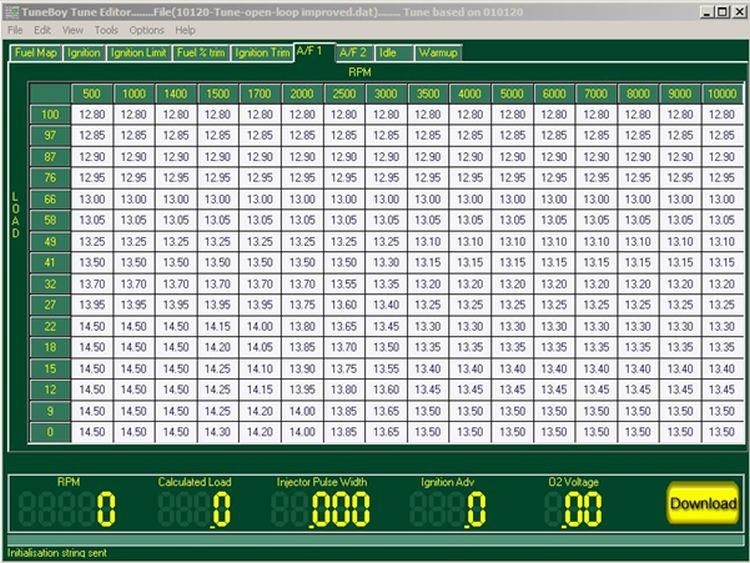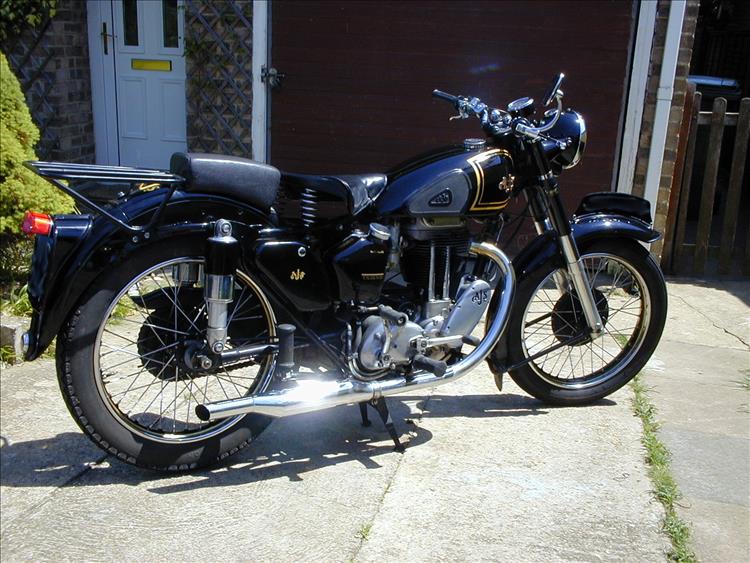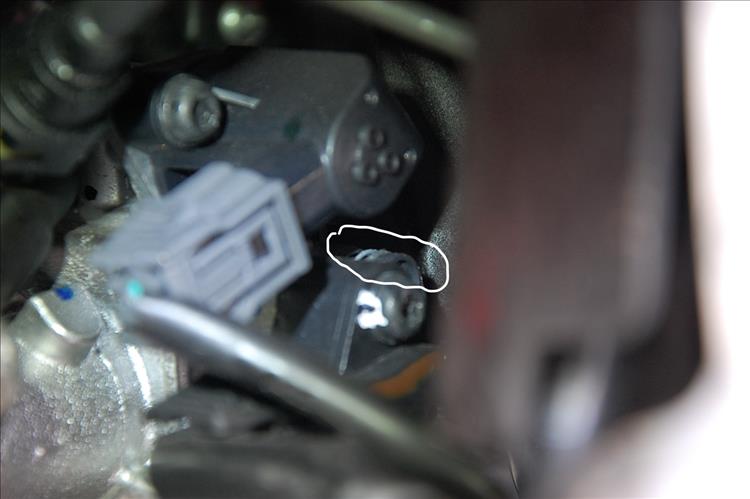Home
Guest Posts
Air/Fuel Maps
Post Received 26 March 2020
By Ian Soady
A short description of air/fuel maps.
Petrol engines work most efficiently at a specific ratio of air and fuel – known as the stoichiometric ratio. It’s when all the fuel will be perfectly burnt leaving just carbon dioxide and water vapour in the exhaust. For petrol it is around 14.7:1 by weight. However, for maximum power it’s better to have a slightly richer mixture – down to around 11: 1. Modern engines will also run happily at weaker ratios – but only to a point as the weaker it is the slower combustion which can lead to burnt valves, holed pistons etc.
So the engine control unit (ECU) will have a target air/fuel ratio which it will try to maintain. This is known as the air/fuel (A/F) map and is often shown as a spreadsheet like grid. For example, this is one for a Triumph Tiger 955i straight out of the box:

The left hand (Y) axis is throttle opening AKA load; the horizontal (X) axis is engine speed. You will see that up to around 1/3 throttle and 6,000 rpm the ratio is close to the ideal 14.7 – actually slightly richer for driveability and throttle response. It gets richer for wider throttle openings and higher engine speed for a variety of reasons including the fact that combustion is less effective under these circumstances and also to provide better throttle response.
The ECU also uses the target of 14.5 to run in “closed loop” mode. This mode uses the CO (lambda) sensor in the exhaust pipe to monitor the exhaust composition. If it sees that the mixture is too weak or rich it modifies the fuel delivery (by adjusting the length of time the injectors are open) to bring it back in line.
This can cause an unpleasant “hunting” effect whereby the throttle seems to be slightly opening and closing regardless of what the rider is telling it. This can be quite unpleasant. It is reputedly designed in so that the bike can pass emissions testing although of course this is not required in the UK. This testing is usually carried out at a specific rev range eg 3000 rpm.
So many Tiger owners including myself changed the A/F map to stop this happening. Here is my map:

You’ll see that it’s slightly richer everywhere except at around idle speed. This map made the bike much nicer to ride and especially at that 3–5,000 rpm area which is where the Triumph engine was at its best. I used proprietary software called Tuneboy to do this; there’s quite a lot of different variants around.
Of course this isn’t the whole story as various adjustments are made to the map to account for fuel and air temperature, ambient atmospheric pressure etc.
People often say that EFI is complicated and of course it is. But in many ways it is easier to tweak the map than it is to faff around changing jets, carb slides, needles etc. It’s also easier to use software such as Tuneboy to read the sensors which means that you’re not having to change components blindly.
Of course the ECU also manages the ignition advance but that’s another subject.
if you can guide our BAT readers gently through a motorcycling subject click here.
Reader's Comments
nab301 said :-
Excellent , thanks for posting
Nigel
03/04/2020 15:50:58 UTC
Ren - The Ed¹ said :-
I'm glad Ian kept this simple for we mere mortals. What I'd like to know Ian is how expensive was the software, how easy was it to install and connect to the Triumph and were you brave enough to alter any of the other settings in the other maps - say Idle and Warm Up?
I'm tempted to have a look to see if there is anything similar for the CBF125 and the CB500X. I actually expect the CBF125 to be "fixed", "hard coded" rather than programmable. Only one way to find out...
04/04/2020 10:39:09 UTC
Ian Soady said :-
In essence it is simple and if you think about how complicated carbs need to be to cater for all sorts of conditions, the A/F map is actually easy to understand. The actual software of course may not be. Most bike carbs are fairly crude devices - either simple slide types (Amal, Mikuni etc) or constant depression (some Mikuni, SU, Stromberg etc). To get really accurate carburation needs a setup with several jets, bleeds, air passages etc like Weber DCOEs.
The software I used (Tuneboy) was actually quite expensive but some time after I bought it a free version was brought out - Tune ECU (see link). Although most bikes have an Onboard Diagnostics (OBD 2) type socket, unlike cars which have to conform to a specific protocol the bikes tend to be proprietary so depend on people reverse engineering the dealer systems. As some people here will know, you can buy a Bluetooth OBD 2 reader for a couple of quid that will allow you to reset error codes etc on a car. It won't let you modify the maps however.
http://www.faultcodereaders.com/tune-ecu-software-for-your-triumph-bike-free/...
04/04/2020 11:06:20 UTC
Ian Soady said :-
Oh, missed a couple of your other questions. No I didn't change anything else as I wasn't trying to get maximum performance. The software was however very useful to do things like reset the throttle position sensor and check the operation of other sensors and actuators. Although I never had any error codes it would also have been very handy to home in on defective devices.
04/04/2020 12:05:43 UTC
Ian Soady said :-
This might be useful for the Honda:
https://www.lonelec.co.uk/Honda-4pin-OBD2-Adaptor...
04/04/2020 12:08:33 UTC
Ian Soady said :-
As might this:
https://hondaflasher.webnode.fi/...
04/04/2020 12:09:19 UTC
CrazyFrog said :-
Excellent article Ian, thanks...
04/04/2020 12:41:22 UTC
Upt'North said :-
Thanks Ian, interesting read.
Never heard carbs referred to as Constant Depression only CV, which I think covers both the common terminologies for such carbs.
Upt'North.
04/04/2020 19:08:52 UTC
Bill said :-
Great animation showing how Constant Velocity carburettor works
https://youtu.be/wyspAHrMbb8...
04/04/2020 22:13:50 UTC
Ian Soady said :-
Stromberg always called their carbs CD but I agree not a term in general use. I had one which I'd removed from a Triumph car kicking about the garage for years as I intended to fit it to my Commando but never got around to it. There was a popular conversion using a single SU and indeed the prototype Norton Commando 76 which never made it to production used one.
05/04/2020 10:02:19 UTC
Bill said :-
Indeed Ian,Zenith-Stromberg carbs operate on the constant depression principle. (The “CD”in the Z-S series designation stands for “constant depression) Constant depression, also known as “constant vacuum”, “constant pressure”, “variable venturi”, or “variable choke”, simply means that the effective area of the carburetor venturi varies according to the engine requirements, producing constant air velocity and pressure differential across the jet orifice during normal running. This condition is produced by the air valve (air piston) rising and falling in response to engine vacuum.
http://www.mossmotoring.com/back-basics-intro-zenith-stromberg-carburetors/...
05/04/2020 10:29:13 UTC
Upt'North said :-
Depending on how long this stay at home goes on for I could end up edumicated.
Or not.
Upt'North.
05/04/2020 12:52:06 UTC
Ren - The Ed¹ said :-
When you look at later carbs they can get REALLY complicated. Watch them Amurican tuning videos and the aftermarket carbs they fit. Beautiful for sure but hell's teeth there's tiny tubes and passages and levers and flaps and pumps and and and all machined into the body.
Thanks for the links Ian. I have a CHEAP ODB2 reader for the car which will cover the absolute basics and reset "essential" errors. For £15 it's be an interesting experiment to see if the cable adaptor would work with the Hondas. The go-to for proper on the fly diagnostics for Honda is HealTech who's kit and software would cost around £150.
Nice easy video Bill - I note the similarity between he idle circuit on the carb against the idle circuit on the EFI diagram I drew above. I guess in this instance the IACV is the equivalent of the pilot mixture screw. It is worth noting that I believe some pilot mixture screws alter the amount of FUEL not AIR going in? I await the wisdom of wiser folks to confirm or deny this.
As for your edumication Upt', you can lead a horse to water but you can't make it drink.
05/04/2020 16:04:03 UTC
nab301 said :-
Ren , one of the reference books I have suggests that (on Keihin carbs at least) if the idle mix screw is upstream of the throttle slide, it is an air screw , ie turning it out will weaken the mixture , i'm making a possibly incorrect assumption that if the screw is downstream of the slide that it is a (Fuel mixture) volume screw , turning it out will tend to richen the idle mixture...
Early injection systems eg my 20yr old Bimmer have air screws or more correctly air by pass screws which are used to control the idle speed and balance the vacuum of the throttle bodies at idle . Fast idle for cold starts is just a pull cable connected to the throttle linkage often incorrectly called a choke cable ...
Nigel
05/04/2020 17:15:26 UTC
Bill said :-
Hi nab I concur
When the screw is on the airbox side of the carb, it is an air screw.
When the screw is on the engine side of the carb, it is a fuel screw. As on my CRF230F.
The difference:
When an air screw is screwed in, it reduces the air flow, so it richens the air/fuel mixture.
When a fuel screw is screwed in, it reduces the fuel flow, so it leans the air/fuel mixture.
05/04/2020 22:45:57 UTC
Ren - The Ed¹ said :-
Woohoo! I was right for once! Makes a refreshing change.
nab301 - when I believed the Idle Air Control Valve might be an issue on the CBF125 I did consider the possibility of somehow making it manual. The act of putting some kind of screw in to control the air flow isn't too bad but I'm pretty sure the computer would throw some kind of hissy fit. Without the IACV plugged in the FI dash light comes on. If I left the IACV plugged in but not doing anything the computer would be trying to control the idle without success. I suspect it wouldn't be happy.
I remember the "choke" on early FI bikes. Essentially it just changed the throttle stop rather than giving the computer control via the IACV.
06/04/2020 08:50:05 UTC
Ian Soady said :-
You might expect me to disagree.....
Amal carbs have the adjuster on the engine side but it is an air bleed adjusting screw. Except (I believe) for the rare and exotic TT racing carb where it controlled the idle fuel supply but then most of us have never encountered these beasts.
06/04/2020 10:06:11 UTC
Bill said :-
Yes Ian the screw is physically on the engine side of the air slide but controls an air bleed passage way. You can't have rules without exceptions ;-)
https://www.oldbritts.com/amal_tun.html...
 06/04/2020 12:00:51 UTC
06/04/2020 12:00:51 UTC
nab301 said :-
Ren , just to be different my CB125F has an idle air screw and a fast idle solenoid valve .....
Nigel
06/04/2020 20:21:50 UTC
Ren - The Ed¹ said :-
Whaaaat? Is that the modern CB125F that replaced my CBF125? Show me show me show me...
07/04/2020 07:50:08 UTC
nab301 said :-
I didn't believe it myself Ren , it's in the latest Haynes manual , so I stripped the covers off the bike soon after I bought it and the air screw is there alright , I've plenty of time , i'll get a photo in the next few days. Yes it's the CB125F in the photo.
 07/04/2020 19:51:32 UTC
07/04/2020 19:51:32 UTC
Ren - The Ed¹ said :-
I'd be interested to see nab301 - this suggests Honda has made the CB125F even simpler (which is good in my opinion) than the CBF125. I figure if the tickover is a tad low/high you alter the air screw and the computer will alter the fuelling accordingly.
07/04/2020 21:41:58 UTC
nab301 said :-
Ren It needs tank off to get a decent photo and I lost interest.. but I've circled it in the poor quality photo below behind the TPS screw , you can just see the coils of the "retaining" spring
 10/04/2020 00:16:51 UTC
10/04/2020 00:16:51 UTC
S Maca said :-
For anybody wanting to really 'see' how a carburetor work, this hi-speed video of a transparent carb in action is really fascinating. It definitely improved my understanding of what a venturi is!
https://youtu.be/toVfvRhWbj8...
04/07/2021 12:11:01 UTC
Ren - The Ed¹ said :-
S Maca - good call! I've had a grasp on how a carb works for a long time but to really truly see a transparent one in slow motion actually at work is delightfully enlightening. I'm already familiar with Destin's channel but to see his father's sheer joy of explaining then watching the slow-mo is truly heart warming. I'd rather watch 2 people learn together in the real world with practical equipment than some dullard mumbling through some CAD slides.
05/07/2021 08:46:41 UTC
Name
Comment
Add a RELEVANT link (not required)
Upload an image (not required) -
Uploading...
Home
Guest Posts